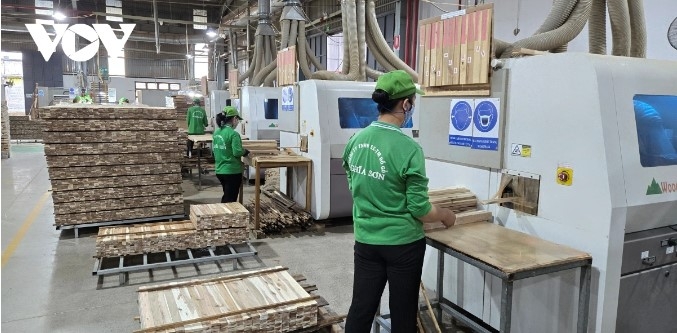Vietnamese enterprises explore new paths amid potential US tax hikes
VOV.VN - Textile and wood product exporters in Ho Chi Minh City are actively preparing for the potential increase in US import tariffs, particularly on goods originating from China. This poses both opportunities and challenges for Vietnamese enterprises, as many rely on raw materials imported from China.

Sourcing new materials
In 2024, Ho Chi Minh City’s textile and garment industry, along with the wood processing sector, achieved robust growth, with export turnover soaring by 11% to 20% compared to the previous year. The US market accounted for 40%-50% of the total export value for both industries.
According to Pham Van Viet, General Director of Viet Thang Jean Co., the US export market began recovering well in September 2024, helping the company record a 16% growth compared to 2023. The company has already secured export orders to the US through June 2025.
Amid concerns over potential tariff hikes on Chinese textiles, increasing from 50% to 60%, Viet Thang Jean has proactively sought materials from Pakistan, Turkey, and Thailand. Even if these countries face higher tariffs, their rates would still be 40% lower than those of China. Additionally, the company is heavily investing in traceability to meet stringent US regulations.
“Currently, the US imposes clear and transparent technical barriers. Businesses must disclose the entire supply chain, from the origin of cotton to the production process. If Chinese materials are used in Vietnamese production, businesses must provide specific declarations to ensure that Vietnamese goods are not ‘disguised’ to gain tax benefits,” Pham Van Viet explained.
Concerns over Chinese firms "hiding behind" Vietnamese businesses
In 2024, Ho Chi Minh City’s wood product exports grew by 20% compared to the previous year. Many wood-processing companies saw significant growth thanks to a recovery in the US and European markets. Nghia Son Wood Company, based in Thu Duc City, posted a 30% increase in exports year-on-year and has secured orders through April 2025.
However, Huynh Le Dai Thang, Director of Nghia Son Wood Company, expressed concerns about the risk of Chinese businesses "hiding behind" Vietnamese companies, creating unfair competition and harming the reputation of Vietnamese products.
“Competent agencies must rigorously monitor and prevent Chinese goods from being ‘disguised’ as Vietnamese exports. If the US investigates and discovers violations, the consequences could be severe for Vietnam’s wood-processing export sector,” Thang warned.

Diversifying material supplies
Some furniture manufacturers using imported wood, plywood, and other materials from China face the risk of higher tariffs. Currently, materials from China make up around 25% of their production input.
Nguyen Chanh Phuong, Vice Chairman and General Secretary of the Ho Chi Minh City Handicraft and Wood Industry Association (HAWA), noted that Vietnamese companies have an advantage as Vietnam’s wood products enjoy a 0% tariff in the US, compared to China’s 25%. However, higher tariffs on raw materials could pose difficulties for businesses heavily reliant on Chinese supplies.
“Diversifying material supplies is essential. Vietnam can source plywood and materials from countries like Thailand and Indonesia, which are strong suppliers of such materials. Currently, about 20%-30% of materials in Vietnam’s textile and wood-processing industries are imported from China,” Phuong stated.
Although a US tariff hike is still speculative, Vietnamese businesses must prepare for potential changes. To enhance competitiveness, enterprises must diversify material sources, improve product quality, and meet international technical standards.
Meanwhile, competent agencies need to strengthen investment controls to prevent “hiding” and “disguising” origin fraud. This not only safeguards the reputation of Vietnamese goods but also supports the sustainable development of the textile and wood-processing industries in the global market.



